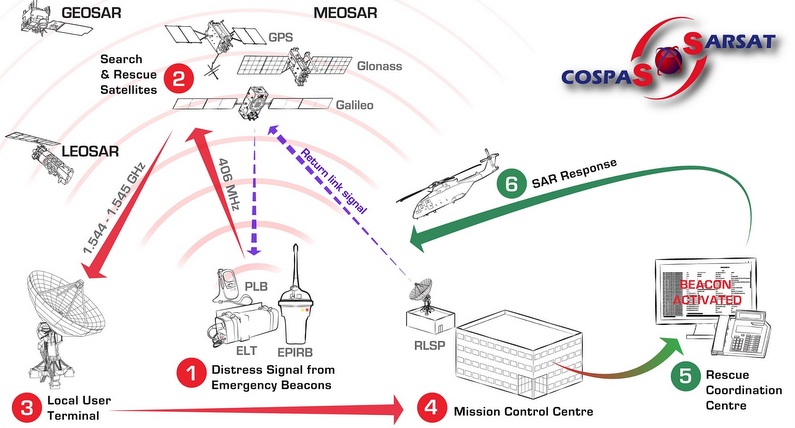
Advances in distress beacon capabilities
Beacons with Return Link Service (RLS) are already here, and those with Second Generation Beacon (SGB) technology arriving in 2022. What are these new capabilities, and what do they mean for SAR in New Zealand?
We acknowledge and thank the Rescue Coordination Centre NZ (RCCNZ) and the Australian Maritime Safety Authority (AMSA) for assisting us to write this article.
Return Link Service (RLS)
Approved by Cospas-Sarsat in March 2021, RLS capable beacons can receive confirmation that the distress signal has been received via a flashing blue or red light on the unit. The flashing light only confirms that the signal has reached the relevant Mission Control Centre; the distress message is then sent onwards to the relevant RCC who then activates SAR resources.
There are strengths and weaknesses in this capability. Only the European Galilleo satellites within the Cospas-Sarsat MEOSAR system can provide the return link signal to the beacon. Even if the distress signal has been received, an RLS indication could be delayed if the satellite in range is not a Galileo satellite. Also, professional opinions vary regarding the influence on survivor behavior when the RLS light illuminates, or fails to. The relevant organisations in our SAR sector will be watching closely as the system rolls out to the public.
For the end user however, confirmation that the signal has been received may provide some reassurance and comfort that their distress beacon is working and has sent a signal out.
Second Generation Beacons (SGB)
These mark a step change in beacon technology, which includes improved location accuracy (to less than 30 metres), smart transmission algorithms, activation cancellation capability, incorporation of the Automated Identification System (AIS) in EPIRBs, and Autonomous Distress Tracking (ADT) in ELTs.
Smart transmission algorithm
SGB’s front load six initial distress, beacon ID and location transmissions,with the next 59 transmissions at 30 second intervals then at two minute intervals thereafter. Position data is sent during the first 30 minutes of activation, followed by updates every 15 minutes. This significantly improves battery life and reduces transmission loading on satellite systems as the number of beacons continues to grow rapidly around the world.
Automatic Identification System (AIS)
AIS is a maritime technology for large ocean-going ships and passenger vessels. It transmits basic information every six minutes via digital VHF radio transmission that is received and interpreted by AIS units on shore or on other vessels. The information includes identity, type, position, course, speed and any safety related information. A more thorough overview of AIS is available on the NATO shipping website
For AIS equipped SGBs, VHF transmission alternates between the 121.5MHz homing signal and AIS distress data signal. AIS equipped vessels can detect that AIS distress signal, and home in on the transmission. AIS provides better information to any first responding ships, who can begin to aid a vessel in distress before it is requested by the authorities.
Autonomous Distress Tracking (ADT)
First generation ELTs would be activated on impact via a G switch, or manually by the pilot. Second generation ELTs with ADT automatically activate if any predetermined distress conditions are met, such as unusual altitude or speed, or total loss of engines. ADT beacons will be required by the International Civil Aviation Organisation from 1st January 2023.
NZ Market place and National Standards
Updated Australia and New Zealand Standards will include the AIS and RLS systems. AS/NZS 4280.1 for EPIRBs will be in effect from 1 July 2022. Certain vessels, under maritime law, are required to carry a standard-compliant EPIRB, so the manufacturers are expected to reserve sale of these devices until the second half of 2022.
Conversely, there are no laws covering most of the situations where PLBs are carried. RLS capable PLBs have been available for sale in New Zealand since May 2022, despite the fact that AS/NZS 4280.2 for PLBs is only expected to be updated by early 2023 because of delays due to COVID-19.
Feature image courtesy of COSPAS-SARSAT. https://www.cospas-sarsat.int/en/search-and-rescue/system-graphics-en
